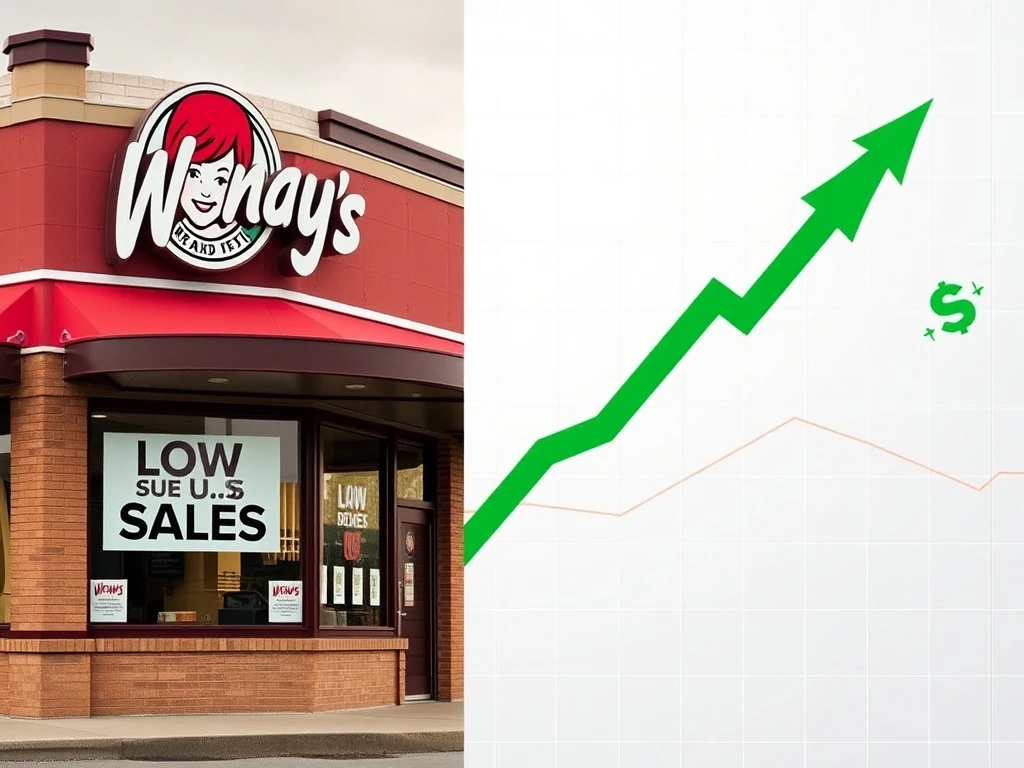Investors often face perplexing situations in the stock market. One such scenario involves a company cutting its profit outlook while its stock price simultaneously rises. This exact paradox recently unfolded with **Wendy’s stock**. The fast-food giant revised its financial projections downwards, citing weaker U.S. sales. However, contrary to conventional expectations, its shares saw an increase. This article delves into the complexities behind this market reaction, examining the factors that influence both corporate performance and investor sentiment. Understanding this dynamic offers valuable insights for anyone interested in business and entrepreneurship.
Understanding the Paradox of Wendy’s Stock Performance
The recent announcement from Wendy’s puzzled many market observers. The company stated it would cut its profit outlook for the fiscal year. This decision stemmed directly from a decline in U.S. sales. Typically, a reduction in profit forecasts signals trouble, often leading to a stock price decrease. Yet, **Wendy’s stock** defied this pattern. Its shares experienced an upward movement following the announcement. This counter-intuitive response suggests underlying factors are at play, beyond just immediate sales figures. Investors often look beyond short-term setbacks, focusing on broader strategic moves or long-term value propositions.
Several elements contribute to such a paradoxical situation:
- Market Expectations: Sometimes, negative news is already ‘priced in’ by the market. If analysts anticipated worse news, a slightly less severe cut might be seen as a positive.
- Strategic Shifts: Companies might announce profit cuts alongside new initiatives or cost-saving measures. These can reassure investors about future profitability.
- Valuation Metrics: Despite weak sales, a company’s stock might still be undervalued based on other financial metrics, attracting buyers.
Factors Influencing Weak U.S. Sales for Wendy’s
Wendy’s attributed its revised outlook primarily to softening U.S. sales. This trend is not unique to Wendy’s; many quick-service restaurants face similar headwinds. Several macroeconomic and industry-specific factors likely contribute to this weakness. High inflation continues to impact consumer spending power. Consequently, many consumers are becoming more selective about their discretionary purchases. They may choose to cook at home more often. Furthermore, the competitive landscape in the fast-food industry remains fierce. Numerous players vie for market share, offering promotions and new menu items. This intense competition makes it challenging for any single brand to maintain consistent sales growth. Economic uncertainty also plays a role. When consumers feel less secure about their financial future, they tend to reduce spending on non-essentials. This cautious behavior directly affects restaurant visits and average check sizes. Thus, Wendy’s faces a challenging environment.
Why Wendy’s Stock Defied Expectations and Rose
Despite the negative sales outlook, **Wendy’s stock** saw a rise. This unexpected movement highlights the complex nature of stock market reactions. Investors often consider multiple factors beyond just the immediate quarter’s sales. One significant reason could be investor confidence in management’s long-term strategy. Perhaps the market believes Wendy’s leadership possesses a robust plan to navigate current challenges. This plan might include cost-cutting measures, operational efficiencies, or new growth initiatives. Furthermore, share buyback programs can boost stock prices. When a company buys back its own shares, it reduces the number of outstanding shares. This action can increase earnings per share, making the stock more attractive. Dividends also play a role. If Wendy’s maintains a consistent dividend payout, it attracts income-focused investors. These investors prioritize steady returns over short-term growth fluctuations. International expansion offers another growth avenue. While U.S. sales may be weak, strong performance in international markets could offset domestic declines. Analysts may also have anticipated a worse outlook, making the actual announcement less severe than expected. This ‘less bad than feared’ scenario often leads to a relief rally. Therefore, a combination of these elements likely fueled the rise in **Wendy’s stock**.
Strategic Moves and Future Outlook for Wendy’s Stock
Wendy’s management is not passive in the face of these challenges. They are actively implementing strategies to improve performance. These strategies often include menu innovation. Introducing new and appealing items can attract customers and boost sales. Digital transformation is another key area. Investing in online ordering, delivery services, and loyalty programs enhances customer convenience. This can drive repeat business. Furthermore, cost management remains a priority. Companies constantly seek ways to reduce operational expenses without compromising quality. Efficient supply chain management helps in this regard. Remodeling older restaurants can also improve the customer experience. A fresh look often encourages more visits. These strategic initiatives aim to bolster future sales and profitability. The long-term outlook for **Wendy’s stock** will depend heavily on the success of these efforts. Investors will closely monitor sales trends, profit margins, and market share. Continued international growth also presents a significant opportunity. The company’s ability to adapt to changing consumer preferences and economic conditions will determine its sustained success. Therefore, the coming quarters will be crucial for the fast-food chain.
Analyst Perspectives and Market Interpretation
Financial analysts play a crucial role in shaping investor perception. Following Wendy’s announcement, many analysts likely re-evaluated their price targets and recommendations. Some might have maintained a ‘buy’ rating, emphasizing the company’s long-term potential or undervaluation. Others might have adjusted their outlook downwards, focusing on immediate sales concerns. The market’s interpretation often reflects a consensus of these expert opinions. Institutional investors, who manage large portfolios, frequently rely on such analyses. Their trading decisions significantly impact stock prices. If major institutions believe the dip in sales is temporary, they might accumulate more **Wendy’s stock**. Conversely, if they foresee prolonged weakness, they might reduce their holdings. Earnings calls provide vital information. Management typically explains their strategy and answers analyst questions during these calls. This transparency helps the market form an informed opinion. Ultimately, the market digests all available information—financial reports, management commentary, and analyst insights—to determine the stock’s value. The recent rise in Wendy’s shares suggests a prevailing optimistic view among a significant portion of investors, looking beyond the immediate profit cut.
In conclusion, the recent performance of **Wendy’s stock** presents a fascinating case study in market dynamics. Despite cutting its profit outlook due to weak U.S. sales, the company’s shares rose. This paradoxical movement can be attributed to several factors. These include market expectations, investor confidence in strategic initiatives, and the potential for share buybacks or international growth. Wendy’s is actively implementing various strategies to counteract domestic sales weakness. These efforts focus on menu innovation, digital improvements, and cost management. The long-term success of these initiatives will be key to sustaining investor confidence. As always, the stock market reflects a complex interplay of current performance, future expectations, and strategic positioning. Investors continue to weigh these elements carefully when evaluating companies like Wendy’s.
Frequently Asked Questions (FAQs)
Q1: Why did Wendy’s cut its profit outlook?
Wendy’s cut its profit outlook primarily due to weaker-than-expected sales performance in its U.S. market. Economic factors like inflation impacting consumer spending likely contributed to this decline.
Q2: Why did Wendy’s stock rise despite the negative profit outlook?
Several factors can explain the rise in **Wendy’s stock**. These include the market already ‘pricing in’ worse news, investor confidence in the company’s long-term strategy, potential share buybacks, or strong performance in other segments like international markets. Analysts might also have seen the outlook as ‘less bad than feared.’
Q3: What strategies is Wendy’s employing to boost sales?
Wendy’s is focusing on several strategies to improve sales. These include menu innovation with new items, enhancing digital platforms for online ordering and delivery, implementing loyalty programs, and managing costs efficiently. They also consider restaurant remodels.
Q4: How does consumer spending affect fast-food chains like Wendy’s?
Consumer spending directly impacts fast-food chains. When inflation is high or economic uncertainty prevails, consumers tend to reduce discretionary spending, including eating out. This leads to fewer restaurant visits and lower average check sizes for companies like Wendy’s.
Q5: Is Wendy’s stock a good investment given the current situation?
Investing in **Wendy’s stock**, like any investment, depends on individual financial goals and risk tolerance. While the stock showed resilience, potential investors should conduct thorough research, consider long-term trends, and consult with a financial advisor. The company’s ability to execute its strategic plans will be crucial.
Q6: What role do international markets play in Wendy’s overall performance?
International markets can play a significant role. Strong growth in overseas operations can help offset weaknesses in domestic markets. Diversifying revenue streams across different geographical regions provides stability and additional growth opportunities for Wendy’s.






















